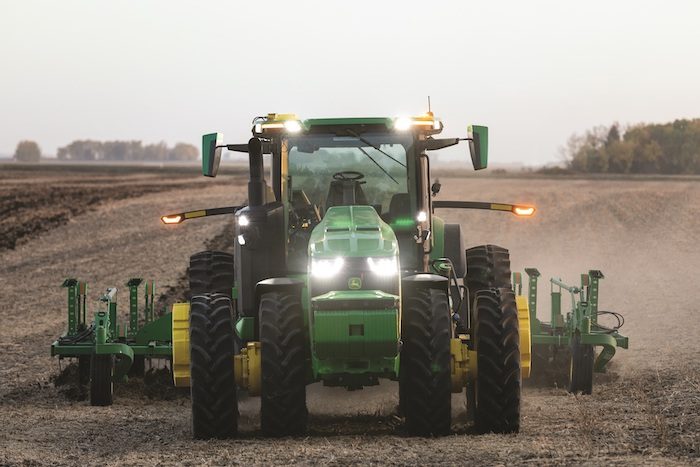“In general, we have manufacturers moving away from historically their role as an iron company into being a technology company.” — Scott Shearer, chair, Ohio State University
John Deere introduced its autonomous 8R tractor to the world at CES 2022 — and autonomy went mainstream.
The machine combines Deere’s 8R tractor, TruSet-enabled chisel plow, GPS guidance system and other new technologies to autonomously till fields. The farmer must transport it to the field and start operations using an app, but once the machine is running, the farmer can leave it to run on its own.
Scott Shearer, chair of the department of food, agricultural and biological engineering at Ohio State University, says the new autonomous tractor is part of a trend of manufacturers moving away from their roles as iron companies and instead becoming technology companies.
In this episode of the Precision Farming Dealer podcast, Shearer shares what surprised him about the announcement of the 8R, his predictions for the future of autonomous farm equipment and what issues he thinks manufacturers shouldn’t ignore when it comes to autonomy.
Related Content
[Technology Corner] Autonomy Goes Mainstream with Deere’s Autonomous 8R Tractor: A Deere spokesperson told Precision Farming Dealer that the autonomous 8R tractor will be delivered to U.S. customers in time for fall tillage operations. However, a report from Bloomberg News says the company expects a slow rollout, with between 10 and 50 autonomous tractors made available to farmers in 2022.
John Deere Fully Autonomous Tractor Ready for Large-Scale Production: During a press conference at CES 2022, John Deere revealed a fully autonomous tractor that’s ready for large-scale production.
Full Transcript
Michaela Paukner:
I'm Michaela Paukner, associate editor of Precision Farming Dealer. Welcome to the latest episode of the Precision Farming Dealer Podcast. New episodes of this series are available wherever you get your podcast. Be sure to subscribe to get an alert when upcoming episodes are released. In today's episode...
Jahmy Hindman:
Autonomy is no longer just a concept or a demo. It's real, it's ready, and it's helping farmers today.
Michaela Paukner:
With that announcement from John Deere's Chief Technology Officer, Deere's autonomous 8R tractor was introduced to the world at CES 2022, and autonomy went mainstream. The machine combines Deere's 8R tractor, TruSet-enabled chisel plow, and other technologies to autonomously till fields. The farmer must transport it to the field and start operations using an app, but once the machine is running, the farmer can leave it on its own.
Michaela Paukner:
Scott Shearer, chair of the Department of Food, Agricultural, and Biological Engineering at Ohio State University, says the new autonomous tractor is part of a trend of manufacturers moving away from their roles as iron companies and toward becoming technology companies. In today's episode of the Precision Farming Dealer podcast, Shearer shares what surprised him about the announcement of the autonomous 8R, his predictions for the future of autonomous farming equipment, and what issues he thinks manufacturers shouldn't ignore when it comes to autonomy.
Michaela Paukner:
I was wondering what your thoughts were and if the announcement of an autonomous tractor to be used for tillage was something that you expected?
Scott Shearer:
I'm going to say, yes, I guess I'm a little surprised by the timing.
Michaela Paukner:
What surprises you about the timing?
Scott Shearer:
I think it's an interesting space and when I look around, and I'm going to talk about the big three manufacturers, the AGCOs, the CNH Industrial, and the Deeres. I think when I look individually at everything that companies are doing, they're all moving towards increasingly autonomous equipment, and I guess what I'm saying is when I look at Auto Steer, when I look at [inaudible 00:02:32], gradually, these companies are removing increasingly more and more control. They're removing it from the operator of the piece of equipment, in other words, the person sitting in the cab of the tractor is really being relegated to, and this is probably an unfair term, but really, a human monitor for performance of that piece of equipment in the field. Some people might say the human's a babysitter now. I don't think that's quite the way it is, but one of the things is when you have a human in the tractor cab responsible for the operation, obviously, that takes care of a lot of potential product liability, as well as liability on the part of the farmer.
Scott Shearer:
So when I say I was a little surprised that Deere made the announcement of a fully autonomous tractor, I guess what I'm saying is, I think it's coming and I think it's going to be interesting to see how Deere rolls out access to this fully autonomous 8R. Relative to the tillage operation, I see that as more than likely, one of the first operations to be automated and my point is, with tillage, you can be off a little bit and nobody's going to get too upset. When I look at automated seeding operations, if you're off on those a little bit, everybody sees that for the rest of the growing season. Automated tillage, automated spraying operations, those make a lot of sense as this automation is in its infancy.
Scott Shearer:
The other thing I'm going to remind you is, we knew Deere was headed in this direction by virtue of their purchases. They bought Blue River, they bought Bear Flag Robotics, and so everything told me they were moving in this direction. I was just a little surprised with the timing of the announcement in some respects. One of the other things I would observe is let's not forget that CNH Industrial purchased Raven at the end of 2021. We can make a lot of statements about a lot of different things but the one thing we do know about Raven is, they had two autonomous products in the marketplace. What was behind Deere's public announcement of the fact that they're going to market that fully autonomous 8R I don't know. I can't get inside of the mind of the leadership of Deere other than to say, in general, I think we have manufacturers like AGCO manufacturers, like CNH industrial and Deere, moving away from historically their role as an iron company, into being a technology company. I don't think anybody would dispute that statement that I've made.
Michaela Paukner:
There have been reports that John Deere is going to offer the autonomous tractor as a service. Do you have thoughts about the logical options for how Deere would go about this?
Scott Shearer:
I thought somewhere in that 45-minute press conference, I heard that they were going to rent or lease these 8R tractors, these autonomous tractors for the first couple of years. I don't know what the marketing strategy is or the marketing plan is, other than to say, as this technology gets rolled out, my guess is Deere's going to learn a lot, and that's going to translate into upgrades to the product as time goes along. I think everybody understands that Deere is probably in a position where they feel comfortable making the announcement and beginning to roll out the product in some form or fashion. But like I said, there's still this liability issue and who's going to assume that liability.
Scott Shearer:
I think it was interesting at the Precision Farming Dealer meeting that the three companies that you had on stage talking about AutoCart, and now what has been renamed OMNiDRIVE, had various ways of handling any liability, and essentially what I heard coming from those three dealers were they had agreements that they require the farmer to sign in terms of accepting liability. Now that product's a bit unique because the only way that product operates is if there is a human in the field operating the combine, and that's the autonomous grain cart. So that's a little different scenario than what Deere has announced because, from my understanding of the press conference, the farmer takes the tractor to the field, initiates the autonomous operation, then the farmer leaves the field. So again, I think it's an interesting, incremental step.
Scott Shearer:
I'm also well aware that OMNiPOWER product, which was the DOT coming out of Canada that Raven purchased and now is being marketed, that's beginning to gain some market acceptance. So I know there's one of the DOTs operating in the state of Ohio if I'm not mistaken, with one of our retailers applying fertilizer. I just think it's an interesting time that at least the two products that I've mentioned with Raven, are being accepted in the marketplace and Deere may be testing the waters in some respects to see what their customers are looking for in the way of automation.
Michaela Paukner:
With CNH already having Raven and OMNiDRIVE now, what does Deere's autonomous tractor mean for the ag equipment industry?
Scott Shearer:
I think if you talked to Deere they would say that they have some developments that are ahead of where CNH is at. I don't know enough about the internals of what Deere is doing versus what CNH/Raven is doing, so I'll put that one to the side because it'd probably be inappropriate for me to comment on that. My take-home message, when CNH bought Raven and when Deere bought Bear Flag Robotics and Blue River, it tells me these companies are serious about automation. It used to be that automation was being done by venture-backed startup companies and I think Deere announcing the autonomous 8R tractor, really means now that automation is becoming mainstream. I think the real question will be, what is the market penetration of Deere's product offering? In other words, five years from now, what percentage of the 8R tractors are being sold in a fully autonomous version?
Scott Shearer:
I think that's the question that a lot of these manufacturers are struggling with. They know automation is here. They know if they're not automating their equipment, they may be at a decided disadvantage in the marketplace but I think largely, the marketplace is being tested right now with some of these new product offerings.
Scott Shearer:
The other thing I'm going to say is, maybe this is fair, maybe it's not, but with the labor shortage right now, especially in rural America, especially with being seasonal in nature with a lot of these producers, some of these products might look pretty attractive to them. I'm reminded of those three dealers that we're talking about AutoCart/OMNiDRIVE, about saying to one farmer that they partnered with, no, this isn't for me, it's only for the big farmers. Then at the end of that demonstration period, the farmer's thinking, hey, I can get by with one less person in the field when I'm harvesting. That's starting to come home. I know here in the state of Ohio, we had a farmer offering to pay $30 an hour for a grain cart operator. That tells me this labor storage problem, it's not perceived, it's real in rural America. So automation may be getting a foothold or may be viewed in a different light because of that labor shortage.
Michaela Paukner:
Before we get back to the conversation, I'd like to invite you to the upcoming Dealership Minds Summit in Iowa City, Iowa, July 26 through 27. This two-day dealers-only conference offers knowledge-packed general sessions, panels, round table discussions, networking, and more. Mark your calendars for July 26 through 27 and register online at dealershipmindsummit.com.
Michaela Paukner:
Now let's get back to the conversation as Scott discusses the factors he believes will influence the market penetration of autonomous farm equipment.
Michaela Paukner:
Do you think is your best guess as to thinking five years down the road what the percentage of fully autonomous tractors being sold will be?
Scott Shearer:
If we got to where there was a market penetration of, and I'm just going to throw out a number and I'm just spitballing here as you might guess, but if we got to 10% in five years, that would tell me that this is real and it's going to continue. A couple of issues to think about, and one of the things I often think about in academia, I think about the scope and scale of the tractor. What I guess I'm going to remind people of is the sweet spot for companies like Deere and CNH and AGCO, is really in the high-horsepower fixed-frame tractor. So probably over 300 horse under 500 horse, that's really where these companies make quite a bit of their profits in some respects.
Scott Shearer:
The other thing I think that becomes important, when I look at what Sabanto is doing, Sabanto ag out of Northern Illinois, they're going with a smaller tractor, but what I will remind people of is, generally those smaller or utility type tractors, and I'll say a 100 horse thereabouts, they're not quite as technologically advanced as those larger fixed-frame tractors. What I mean is CAN-Bus is relatively new on some of these horsepower tractors. I know Deere has some offerings in the 6,000, 5,000 series now with CAN-Bus on them, but they've just come into the marketplace recently. They don't necessarily have the advanced hydraulics and what I'm talking about is load sensing. They don't necessarily have the electric over hydraulic control that a lot of these high-horsepower fixed-frame tractors do.
Scott Shearer:
So when I watch this automation rollout, the question is going to be, what is the marketplace looking for? Are they looking for high-horsepower tractors that are automated, or as I've been advocating, do farmers begin looking at smaller tractors and farming-as-a-service? Does that become something that's commonplace in the market? In other words, historically we've always thought about farmers owning the equipment, but again, with farming-as-a-service, that may change a bit, and I keep thinking about the scale of a farmer as well. Big equipment is still going to tend to favor large farmers in terms of the economics.
Scott Shearer:
The other thing that comes to mind is creature comfort. In other words, when I look at that 8R tractor, at least what Deere unveiled, it still has a cab on it, it still has all the creature comforts, the air conditioning, the air suspension seat, and things of those nature. If we think about the tractor in the future and we don't have a human operator on it, it becomes a much more utilitarian piece of iron. It becomes a framework to hang technology on. So I guess that's going to determine what happens in the future in terms of the marketplace. And that's where I think the jury is still out at this point in time. Did Deere make the right decision in terms of automating the 8R tractor or should they have automated something smaller? The marketplace is going to determine that. There's probably a lot of people within Deere that have a much better grasp on that size issue than I do.
Michaela Paukner:
We have a couple of financial investment advisors and analysts who send us their input, and one of them mentioned that the autonomous market actually could really take off with the smaller farmers who are people who have another job outside of their small operation, and that's where this could become really valuable to totally remove themselves from this. So that's a really interesting point about how they chose to automate the 8R model versus something else.
Scott Shearer:
Generally, we continue to see an increase in tractor size, combine size, even sprayer size. One of the other things that might drive some of this shift towards automation, at least in the state of Ohio and I'd say this is probably true throughout a lot of the Midwest, farmers planted their corn from April 15 to May 15, and then they planted soybeans from May 15 to June 15. We have farmers in Ohio, just like in Illinois, that are learning if they plant their soybeans first, their profit goes up quite a bit in terms of soybean yields. We're all finding that soybeans might be a little bit more tolerant of cold weather than we thought they were. What I'm seeing now is, and I'll try to make this statement in a very constructive way, farmers that are able to plant both their corn and soybean crops probably in a 15-day window, are well-positioned in terms of profitability.
Scott Shearer:
Timing in this is everything. So the question is, are they going to double their planning capacity, and if they do that, how do they do that? I think automation is one way to do that and that is going from a 14 to 16 hour day to that 24/7 type operation that automation provides. I like watching Sabanto and it's going to be interesting to see how successful [Craig 00:15:55] is with the model that he has. By the way, one of the other factors that Craig keyed in on was, he started out with 200 horse tractors and pretty quickly went to the 100, 115 horse tractor and according to Craig, to move the 200 horse tractor, he needed to schedule a tractor-trailer and somebody with a CDL. With the 115 horse tractor, any worker with a pickup truck and a gooseneck trailer could move that tractor between fields. So that's going to be a continuing concern.
Scott Shearer:
I think Deere choosing to automate the 8R and then looking at their press release, they said, the farmer drives the tractor to the field, once it gets in the field, they start it up and then allow the tractor to perform its function. I think that issue of moving equipment between fields is going to remain front and center in terms of how it's done. I'm going to point to DOT. It's a bigger tractor. I'm going to say higher horsepower as well as greater weight, and you don't have much in the way of options of moving that between fields, at least on public thoroughfares, other than to load it up and truck it. So discount the importance of being able to move equipment between fields.
Scott Shearer:
We know that a lot of our Ohio farmers are spread out north to south and east to west as well, especially those farming higher acreages and that can be 50 to 75 miles from the extents of their fields in terms of what they're farming cash running and in some cases what they own. So that's going to be one of those things we need to pay attention to, is being able to move equipment between fields.
Michaela Paukner:
Definitely something to watch.
Scott Shearer:
There is value in going to smaller equipment outside of this ability to transport. What I continue to say is there's a compaction penalty that farmers are paying, especially in wet years, and by the way, if you compact the soil during a wet year, I'm going to say the gift is not too kind in the out years is either, in other words, we're going continue to see compaction effects in those soils for 5 to 10 years after that event has occurred. I'm still banking on gross vehicle weight and being able to reduce that as being one of those driving factors in the shift towards automation. Right now, I'm not going to argue that labor might be one of those things that a lot of people are looking at, but let's don't discount some of the other factors too.
Michaela Paukner:
It's exciting to see what's going to happen next and how the market's going to react to this.
Scott Shearer:
I've been talking about this for a long time. 10 to 15 years ago, I'd walk into a room and farmers would just roll their eyes. They don't do that anymore. I think everybody understands, it's inevitable. I think the rollout and the success of some of these companies is going to be pivotal in terms of farmer adoption of the technology.
Michaela Paukner:
Thanks to Scott Shearer for analyzing the big picture impact of Deere's autonomous 8R tractor. If you'd like to see the machine in action and read more analysis about what it means for Deere as a company, we have a link in the webpage for this episode to our previous coverage. Go to precisionfarmingdealer.com/podcast to check it out. Let us know what you and your customers think about the possibility of having an autonomous machine for tillage.
Michaela Paukner:
Leave a comment about this episode on our website. Send me an email at mpaukner@lessitermedia.com or give me a call at (262) 777-2441. Looking forward to hearing from you. From all of us here at Precision Farming Dealer, I'm associate editor, Michaela Paukner. Thanks for listening.
Intro Music: Squire Tuck - Rush to the Head
Interlude Music: Squire Tuck - Expressing One's Emotions in Public











